2010 Sea-Doo Lineup Preview
PWC market leader continues to push innovation
You can say one thing for certain about Sea-Doo: the company is never boring. Even in a down year and facing a depressed economy, the company has stuck to its “Sea-Doo is Innovation” theme, cranking out new models, and new technologies, for the coming 2010 model year.
Some of that news was expected — the brake/shift/throttle technologies introduced in ’09 have begun to trickle down the pike. Some, however, like new twists on throttle control and an innovative trailer concept, continue to show Sea-Doo isn’t afraid to blaze a trail, even as much of the competition appears to be sticking to the established path.
For the 2010 line’s introduction to the press, Sea-Doo chose Washington, DC. Here’s what I saw during an extended ride on the Potomac…
iControl Takes Control
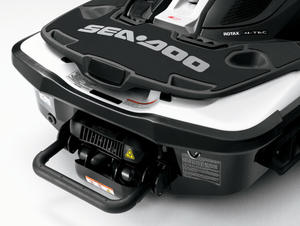 You can see the reverse/brake assembly on the 2010 GTX 215 iS.
You can see the reverse/brake assembly on the 2010 GTX 215 iS.The primary theme for 2010 is the continued spread of iControl, Sea-Doo’s all-inclusive name for the iBr (intelligent brake and reverse), iS (intelligent suspension), and iTC (intelligent throttle control) technologies introduced on the 2009 GTX Limited iS and RXT iS. The GTX 215 iS receives the whole package. Sea-Doo has wisely, however, opted to share the package, less suspension, with four additional models — the RXT-X, RXT 215, GTX 155, and Wake Pro 215. All four boats now receive the S3 stepped hull introduced on last year’s suspension models, but with a fixed top deck that boasts the new family looks introduced on the iS models in ‘09. Foregoing the suspension trims not only substantial cost, but also significant weight, which should aid performance. It also, perhaps for the first time, allows the S3 hull to truly shine. In calm conditions on the RXT-X, it cornered with utter precision, carving corners as tight as I could muster.
As I’ve stated before, the suspension concept is cool, but it’s the brake and shift developments that have the greatest long-term potential. Like last year, boats with iBR start in a neutral mode at the dock, rather than lunge forward, thanks to the onboard computer carefully controlling the position of the reverse bucket. Shifting into forward or reverse is accomplished with an intuitive pull of either the right or left handlebar-mounted lever. Eyes never leave the water, and hands never leave the handlebars. And yes, should you need to stop, the brake is there. Like last year, it’s surprisingly effective, dropping the reverse/brake bucket to slow the craft in half the distance of a similar craft without the brake.
On to the intelligent throttle control portion of the equation. Last year, Sea-Doo introduced electronic throttle, a feature that eliminated the physical cable that linked throttle to engine. With that innovation came the expected cruise control and no-wake zone modes. This year, however, they’ve gone beyond those relatively simple solutions and allowed drivers to also choose individually calibrated acceleration curves. The above boats will now start up in what is dubbed a “touring” mode. Acceleration will be somewhat gentler en route to the boat’s top speed. Choose “sport” mode, however, and a warning will flash across the display to tell your passenger to hold on tight. Heed it. Sport mode boasts a much more aggressive curve, hitting extremely hard on the low end. As a Sea-Doo rep explained in the press briefing, electronic throttle control has opened the doors to a lot of new possibilities.
Brave New World
Such as “ski” mode. Featured on the Wake Pro 215, ski mode allows the user to choose from one of five pre-programmed curves. Choose 1 and you get a gentle acceleration for the kiddies, 3 and you get a nice wakeboard takeoff, 5 and you get a hammer-down acceleration for that heavy slalom skier. Ski mode also allows the driver to input the desired towing speed, which it will then hold as closely as possible.
A little more tinkering with the iControl works has allowed Sea-Doo to now claim 260 horsepower, equaling Kawasaki’s current Ultra 260X. As I’ve noted before, Sea-Doo takes full advantage of the marketing allowance when naming horsepower, so it’s likely this engine is not a true 260hp powerplant. Still, does it matter? Top speeds of the premier models will be capped by the GPS speedo at 67 mph. Acceleration will also likely continue to lead the pack, especially now that more aggressive acceleration curves can be chosen at will. During the press intro, the RXT-X 260 literally bolted out of the hole en route to a GPS-confirmed 70 mph. Apparently the speedo wasn’t restricting this particular model…whoops.
Sea-Doo also claims being able to play with the engine electronically has enabled them to boost fuel savings as well. The brand plans to aggressively market this message in the coming year.
Other techno-goodies? Fuel consumption displays have been added to all models with iControl, and displays include usable information like both distance- and time-till-empty displays. RXT models now also feature an advanced handlebar setup. With an Allen key, the user can now make them wider or narrower, adjust the actual grip angle, and control overall tilt.
Elsewhere, the brand continues on with the RXP-X, RXP, GTi SE, GTI, and Wake 155, all familiar machines that now feature graphic or color updates.
2010 Sea-Doo Pricing
| Model | MSRP |
| GTX Limited iS | US$16,499 / C$19,799 |
| GTX iS | US$14,699 / C$17,699 |
| GTX | US$11,599 / C$13,899 |
| RXT iS | US$14,999 / C$17,999 |
| RXT-X | US$14,199 / C$16,999 |
| RXT | US$12,999 / C$15,999 |
| GTI SE 155 | US$9,999 / C$11,999 |
| GTI SE 130 | US$8,999 / C$10,799 |
| GTI | US$7,999 / C$9,599 |
| RXP-X | US$13,499 / C$16,199 |
| WAKE Pro | US$13,499 / C$16,199 |
| WAKE | US$10,399 / C$12,499 |
On The Road Less Traveled…
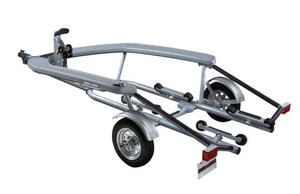 The Advanced Tec iCatch I is a PWC-specific hauler. Check out the photo gallery to see more trailer pics.
The Advanced Tec iCatch I is a PWC-specific hauler. Check out the photo gallery to see more trailer pics.And yes, as mentioned above, Sea-Doo has even pushed innovation into the trailer market. According to company reps, what’s available on the market are essentially boat trailers, made to fit PWC. That fact, along with the statistic that almost 50% of their models are sold with a single-place trailer, has prompted the company to try and change the trailering experience in typical Sea-Doo fashion.
The first development is called the Advanced Tec iCatch I, a $1,399 premium model that features a hands-free system that snags the craft’s bow eye as it glides across roller bunks onto the trailer. A wraparound “walk pad” doubles as a guidance system to position the craft right every time, and allows the PWC occupants to simply stroll off the trailer with ease. When it comes time to launch, a release mechanism is built into the walk pad within easy reach of a seated driver.
I tested the system out at a local launch ramp and it worked to perfection. The overall design allows tow vehicles to stay out of the water, and torsion axles translate into a premium ride on the highway. A cheaper $799 base trailer, also with torsion suspension, is also offered with traditional bunks and winch-and-tackle.
Related Reading
2009 Sea-Doo GTX Limited iS 255 Review
2009 Sea-Doo RXT iS 255 Review
2009 Sea-Doo RXT-X 255 Review
2009 Sea-Doo RXT 215 Review
Get PersonalWatercraft.com in your Inbox!
Like PersonalWatercraft.com on Facebook
Comments
Most Popular

Remembering the Sea-Doo XP

2025 Yamaha JetBlaster PRO 2-Up Review

2024 Yamaha GP HO Review

2024 Kawasaki Jet Ski STX 160X Review

2017 Kawasaki Jet Ski Ultra 310LX Review
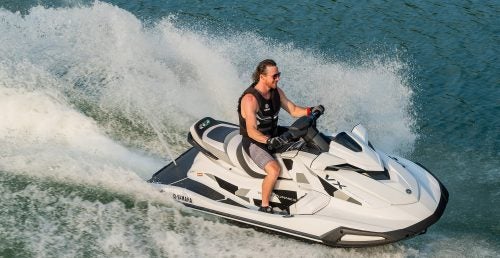



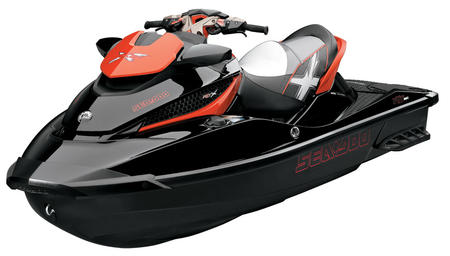
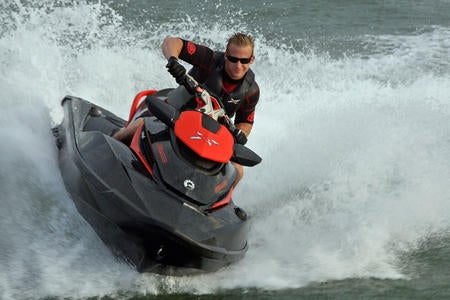
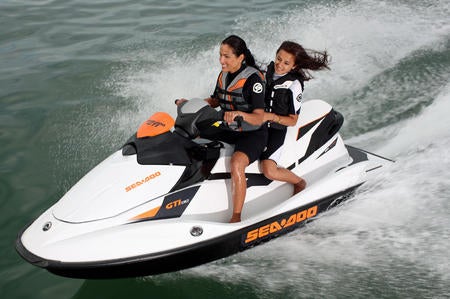







 Your Privacy Choices
Your Privacy Choices